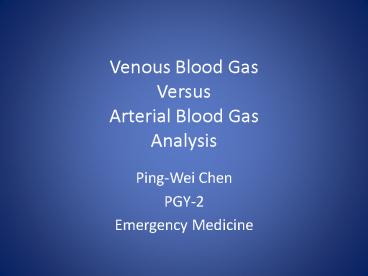Venous Blood Gas Versus Arterial Blood Gas Analysis - PowerPoint PPT Presentation
1 / 16
Title:
Venous Blood Gas Versus Arterial Blood Gas Analysis
Description:
Venous Blood Gas Versus Arterial Blood Gas Analysis Ping-Wei Chen PGY-2 Emergency Medicine It s Go Time 25 yo female Single vehicle rollover near Sundre ... – PowerPoint PPT presentation
Number of Views:415
Avg rating:3.0/5.0
Title: Venous Blood Gas Versus Arterial Blood Gas Analysis
1
Venous Blood Gas VersusArterial Blood
GasAnalysis
- Ping-Wei Chen
- PGY-2
- Emergency Medicine
2
Its Go Time
- 25 yo female
- Single vehicle rollover near Sundre
- Intubated for deteriorating GCS
- In the ED
- BP 70 palp, HR 122
- Not responding to painful stimuli
- 0123 - VBG ordered as part of workup
- 0141 ABG ordered as part of workup
3
Objectives
- Controversy
- Can VBGs replace ABGs?
- When are VBGs and ABGs different?
- When might I want an ABG?
- NOT covered
- Electrolytes
- Lactate
4
Whats all the fuss about?
- Arterial Blood Gas
- Venous Blood Gas
- PAINFUL
- Arterial injury
- Thrombosis with distal ischemia
- Hemorrhage/hematoma
- Aneurysm formation
- Median nerve damage
- Infection
- Needlestick injury
- Reflex sympathetic dystrophy
- Samples can be drawn simultaneously at time of
venipuncture - Should be done without tourniquette
- More difficult to obtain in pulseless patients
- Controversy regarding level of agreement with
arterial values
5
- Prospective, observational study
- 218 subjects, ED population
- dyspnea, DKA, renal failure, seizures, ?LOC,
ingestions, ischemic colitis - A priori definition of clinically important
difference - Pearson correlation coefficient
- Bland-Altman plots
Rang et al. 2002. Can J Emerg Med 4(1)7
6
Results
- Excellent correlation
- pH (r 0.913)
- pCO2 (r0.921)
- calculated HCO3 (r0.953)
7
Results
- Clinically Important Differences
- 26/45 physicians responded
8
Result
- Mean Differences
- pH 0.036 (0.030-0.042)
- pCO2 6.0 mm Hg (5.0-7.0)
- HCO3 1.5 mEq/L (1.3-1.7)
9
- Prospective, observational study
- 246 subjects, ED population
- acute respiratory disease, suspected metabolic
disorder - pH only
- Results
- Excellent correlation r0.92
- Mean difference 0.04 pH units (-0.11 to 0.04)
Kelly et al. 2001. Emerg Med J. 18340
10
- Prospective, observational study
- 95 patients, ED population
- AECOPD, pneumonia, sepsis, ARF/CRF, DKA, ACS,
acute gastroenteritis, SLE, toxic ingestion - Bland-Altman Analysis
- Results ABG compared to VBG
Mean Difference 95 Limits of Agreement
pH 0.015 -0.1 to 0.13
PCO2 -3 -7.6 to 6.8
HCO3 -0.74 -5.8 to 4.3
PO2 65 -32.9 to 145.3
11
- Review article 6 studies
- pH and HCO3
- Results
- Mean difference
- pH 0.02 (-0.009 to 0.021), n258, DKA patients
only - pH 0.037 (-0.11 to 0.04), n 763,
respiratory/metabolic illness - HCO3 -1.88 mEq/L (N/A), n 21, DKA patients only
- HCO3 -0.99 mEq/L (-2.73 to 5.13), n763,
respiratory/metabolic illness
12
When are they different?
- Weil et al. 1986. Difference in acid-base state
between venous and arterial blood during
cardiopulmonary resuscitation. NJEM. 315153-6. - Prospective, observational study (n16)
- ICU/CCU patients
- Arteriovenous gradient
Pre-Arrest Arrest
pH 0.060.02 0.300.05
pCO2 112 mmHg 366mmHg
13
So when might I want an ABG?
- Unable to establish IV access
- Inability to obtain sample
- Inability to obtain O2 saturation by pulse
oximeter - Peripheral vasoconstriction
- Abnormal hemoglobins
- Carboxyhemoglobin
- Methemoglobin
- Sickle hemoglobin
14
N 1
- VBG at 0132
- pH 7.11/pCO2 41/HCO3 14/lactate 6.6
- ABG at 0141
- pH 7.12/pCO2 34/HCO3 11/lactate 6.1
15
Conclusions
- VBGs not interchangeable with ABGs BUT
- Excellent correlation with ABG values
- Reasonable agreement on VBG for clinical decision
making in ED - pH 0.02-0.04 lower
- PCO2 3-6 mmHg higher
- HCO3 essentially the same
- Consider ABG in
- Inability to obtain sample
- Inability to utilize pulse oximeter
16
Questions?































